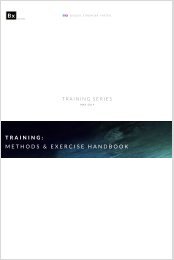Create successful ePaper yourself
Turn your PDF publications into a flip-book with our unique Google optimized e-Paper software.
HTKSPORT<br />
Generally training intensity and specificity are inversely related – that is, the<br />
more specific (complex) the movement is, the less intensity will be able to be<br />
added to it in training (before it is altered to a new and different stimulus), and<br />
vice versa. This is why it is easy, for example, to overload the squat movement (i.e.<br />
add intensity), but more difficult to load footwork drills (without altering or slowing<br />
them down significantly). With regards to complex movements, it is important to<br />
separate the optimising recruitment and neural patterning from overload training –<br />
the best way to get more efficient at complex movements (recruitment/pattern<br />
efficiency) is to go out and practice them. The key to improving performance in those<br />
movements (once optimal recruitment is obtained) is a good understanding of how to<br />
functionally train. This is discussed further below.<br />
I think it’s very important to realise that performance is a combination of an input and<br />
the physical ability to express that input; many training methods only focus on<br />
improving the physical structures. In some instances simply training the structures<br />
will have a positive affect on the performance, but more often than not focusing<br />
solely on training structures without equally focusing on the (neural) input will train<br />
the structures in a way that doesn’t carry over to the final performance. For example,<br />
sprinting or explosive leg speed is often associated with being glute-dominant or<br />
having a well developed posterior chain; does this mean doing hamstring curls and<br />
glute kickbacks to build a bigger set of glutes and hamstrings will make you faster? In<br />
most cases, no. However, if you train to get more explosive legs and faster sprint<br />
speed, then chances are you will be or become glute-dominant and have good<br />
relative posterior chain development. Additionally, if you add to that some training<br />
that specifically aims to increase the horsepower of the glutes and the explosive<br />
strength of the hamstrings, then you will improve your ability to get more explosive<br />
legs and faster sprint speeds. In short, the best functional training methods train the<br />
nervous system to tell the body want you want it to do, and train the body to<br />
maximally respond to that message/input.<br />
07<br />
JUNE 2018 | ISSUE 01




